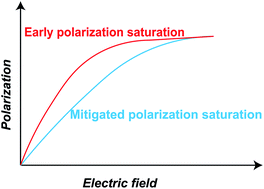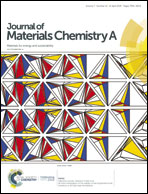Ultra-high energy storage performance with mitigated polarization saturation in lead-free relaxors†
Abstract
Relaxor ferroelectric ceramics have attracted much attention for storing the electricity generated from clean and renewable energy sources due to their high permittivity and near-zero remnant polarization. The polarization of many relaxor based ceramics tends to saturate at high electric fields, however, which limits their energy storage performance. In this study, a lead-free Sn-modified (Na0.5Bi0.5)TiO3–SrTiO3 system is investigated, where mitigated polarization saturation is observed with the addition of Sn4+, as a result of the different electronic configurations between d10 Sn4+ and d0 Ti4+. As expected, high energy density of 3.4 J cm−3 and energy efficiency of 90% are simultaneously achieved in (Na0.25Bi0.25Sr0.5)(Ti0.8Sn0.2)O3 ceramic. In addition, the ceramic exhibits good thermal stability, with the energy storage property variations below 5% over the temperature range of −20 °C to 150 °C, and satisfactory cycling stability with a variation of less than 8% over 105 cycles. All these merits demonstrate that the (Na0.25Bi0.25Sr0.5)(Ti0.8Sn0.2)O3 ceramic has great potential for high power energy storage applications.

- This article is part of the themed collection: 2019 Journal of Materials Chemistry A Most Popular Articles


 Please wait while we load your content...
Please wait while we load your content...